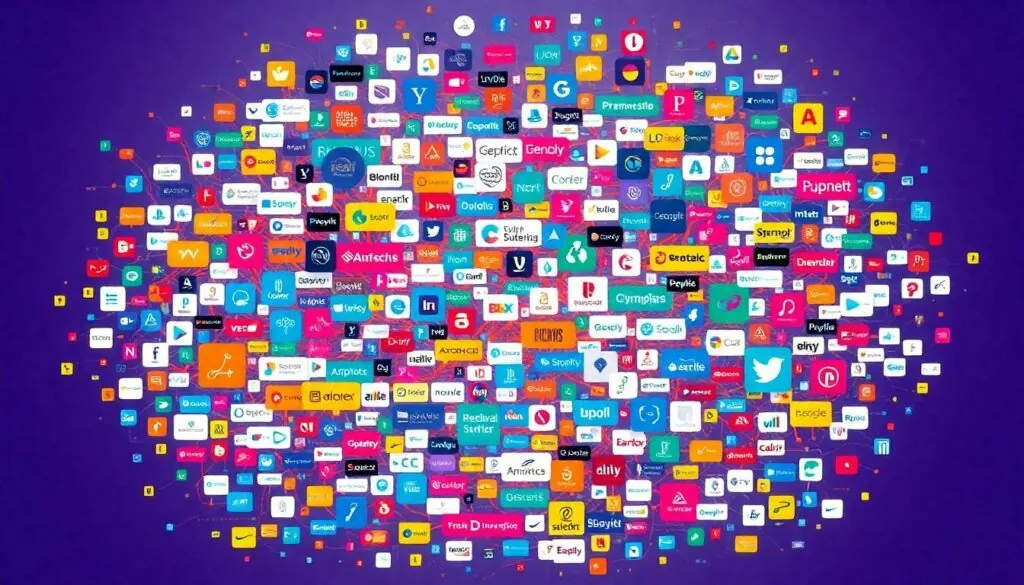Table of Contents
ToggleIn the ever-evolving world of marketing technology, the Lumascape martech landscape can feel like a maze designed by a particularly mischievous cat. With thousands of companies vying for attention, navigating this colorful chaos might seem daunting. But fear not! This vibrant ecosystem is more than just a jumble of logos; it’s a treasure trove of tools that can transform marketing strategies from mundane to magnificent.
Overview of Lumascape Martech
Lumascape martech represents a vibrant ecosystem of marketing technologies shaped by over 8,000 companies. Many organizations rely on this landscape to optimize their marketing efforts, targeting customers more efficiently through various tools and platforms. Analytics solutions, social media management tools, and customer relationship management systems are just a few critical categories within this space.
Navigating the Lumascape requires a clear understanding of its segmentation. Categories often include advertising technology, content marketing platforms, and data management tools. Each type serves specific marketing needs, streamlining processes and improving communication with customers.
Organizations must assess their requirements before choosing tools from the Lumascape. Top industry players frequently integrate multiple solutions to enhance their marketing stacks, making most strategies more robust and adaptable. For example, combining social media analytics with email marketing tools offers deeper insights into customer behavior.
Investments in Lumascape martech continue to surge, reflecting increasing reliance on technology in marketing strategies. According to recent reports, the global market size for marketing technology reached $121 billion in 2021 and is projected to grow at a compound annual growth rate (CAGR) of 14.3% through 2028. This growth emphasizes the importance of companies effectively utilizing these platforms to remain competitive.
Collaborations between different tech companies strengthen the Lumascape ecosystem. Partnerships allow businesses to build more comprehensive solutions, offering better value to marketers. Consequently, focusing on integration across platforms enhances overall efficiency and performance in marketing efforts.
Key Players in Lumascape Martech

The Lumascape martech landscape features numerous influential companies driving innovation and growth. Key players continually shape the market with robust solutions.
Major Companies
Adobe leads the sector with its suite of marketing tools, including Adobe Experience Cloud, which integrates analytics and content management. Salesforce revolutionizes customer relationships through its CRM platform, offering valuable insights for marketers. HubSpot provides an all-in-one inbound marketing solution, attracting businesses with its user-friendly interface. Oracle’s Marketing Cloud offers automation and data-driven insights, allowing companies to leverage customer data effectively. SAP enhances enterprise marketing with its extensive software lineup, focusing on analytics and performance solutions.
Emerging Startups
Emerging startups also play a vital role in Lumascape martech. Segment focuses on customer data infrastructure, enabling businesses to personalize marketing strategies effectively. Amplitude provides product analytics, helping teams track user engagement and optimize experiences. Clearbit enhances lead generation with its real-time data enrichment tools. Drift employs conversational marketing technology, allowing companies to engage potential customers instantly. Poplar integrates brand management within e-commerce platforms to streamline campaign efforts. Each of these startups addresses unique needs, contributing to the evolution of marketing technologies.
Trends Shaping Lumascape Martech
The Lumascape martech landscape evolves rapidly, reflecting significant trends like data privacy and automation. These trends play crucial roles in shaping marketing strategies and technologies.
Data Privacy and Compliance
Data privacy remains a top concern for organizations navigating the Lumascape. Various regulations, such as GDPR and CCPA, demand strict compliance. Companies that prioritize transparency and security build trust with their customers. Ensuring proper data handling practices prevents costly breaches or penalties. Many martech platforms now include features that enhance compliance, simplifying processes for marketers. Leveraging tools with built-in privacy safeguards demonstrates a commitment to protecting user data. As regulations evolve, adapting strategies remains essential to maintain compliance and customer confidence.
AI and Automation Integration
AI and automation significantly impact the Lumascape martech landscape. These technologies streamline marketing efforts and improve efficiency. AI-driven analytics tools provide insights that enhance customer targeting and personalization. Brands increasingly rely on automated solutions for tasks like email marketing and social media posting, freeing up time for strategic initiatives. Moreover, combining AI with existing tools leads to smarter decision-making. Seamless integration allows for better campaign management and real-time adjustments. Focusing on AI and automation fosters growth and keeps organizations competitive in an ever-changing market.
Benefits of Using Lumascape Martech
Enhanced marketing efficiency represents a primary advantage of utilizing Lumascape martech. Organizations can streamline workflows through analytics solutions, social media management tools, and customer relationship management systems. Improved targeting of customers occurs as these tools allow for data-driven decision-making.
Integration of multiple platforms serves a significant benefit. Businesses that combine social media analytics with email marketing gain deeper insights into customer behavior. Such integrations also enable a more cohesive strategy that aligns with overarching business goals.
Cost-effectiveness is another key aspect. The global market size for marketing technology reached $121 billion in 2021, demonstrating that efficient tools can save organizations both time and resources. Investing in the right solutions can lead to a higher return on investment.
Data privacy compliance stands as a critical benefit. As regulations like GDPR and CCPA intensify, organizations using Lumascape martech can enhance transparency and trust with customers. Many platforms include features that prioritize compliance, ensuring businesses navigate regulatory landscapes effectively.
Automation features transform traditional marketing practices. AI-driven analytics enhance targeting and personalization, freeing up valuable time for creative initiatives. Businesses focusing on automated solutions can minimize manual tasks, thus improving overall efficiency.
Scalability of these tools supports team growth. As organizations expand, martech platforms allow for customization to meet evolving needs. Such adaptability ensures alignment with dynamic market trends and customer demands.
Challenges in the Lumascape Martech Landscape
Navigating the Lumascape martech landscape presents several challenges for organizations. The sheer number of available tools exceeds 8,000, creating confusion in selection processes. Companies often struggle with identifying which solutions best meet their specific needs. Decisions made without a clear understanding frequently lead to suboptimal tool integration.
Data privacy regulations, including GDPR and CCPA, remain pressing concerns. Organizations must prioritize compliance to build customer trust, setting a robust foundation for their marketing efforts. Additionally, many martech platforms necessitate continuous updates to adhere to evolving privacy laws, requiring dedicated resources.
Integration issues arise as companies attempt to merge multiple platforms effectively. Successfully aligning different technologies promotes efficiency but comes with significant technical hurdles. Many organizations lack the expertise needed to implement these integrations smoothly.
Budget constraints can hinder investments in the right solutions. The global martech market reached $121 billion in 2021 and is projected to grow at a CAGR of 14.3% through 2028, emphasizing the need for strategic financial planning. Choosing tools that deliver measurable returns becomes crucial for sustainability.
Automation technology has also contributed to challenges. While automating tasks increases efficiency, reliance on automation can overshadow the human elements of marketing. Marketers must strike a balance between using automated solutions and maintaining personalized customer interactions.
Lastly, keeping pace with emerging trends proves difficult as new technologies continually reshape the landscape. Adoption of AI-driven solutions not only enhances customer targeting but requires ongoing training and adjustment. Organizations that adapt successfully position themselves ahead in this competitive environment.
The Lumascape martech landscape is a powerful tool for organizations looking to enhance their marketing strategies. With thousands of companies and innovative solutions available, businesses can optimize their efforts and better connect with customers.
However, navigating this complex ecosystem requires careful consideration and strategic planning. By understanding their unique needs and leveraging the right tools, organizations can streamline operations and improve overall marketing performance.
As the landscape continues to evolve, embracing trends like data privacy and automation will be essential for maintaining a competitive edge. Ultimately, the right approach to Lumascape martech can lead to significant growth and success in today’s dynamic marketing environment.



